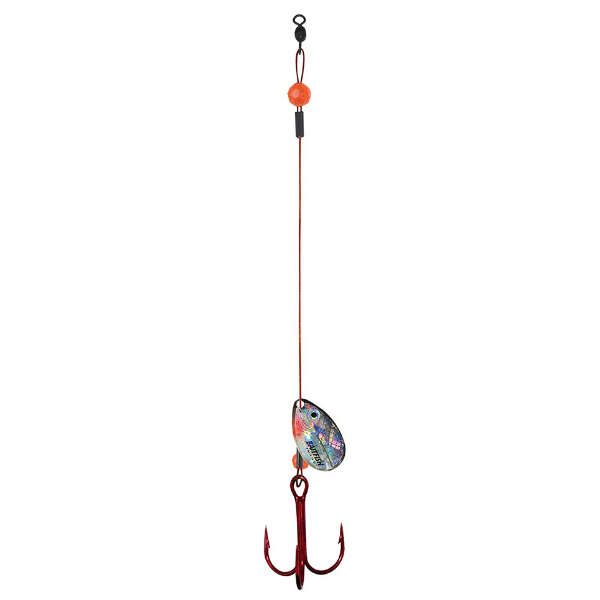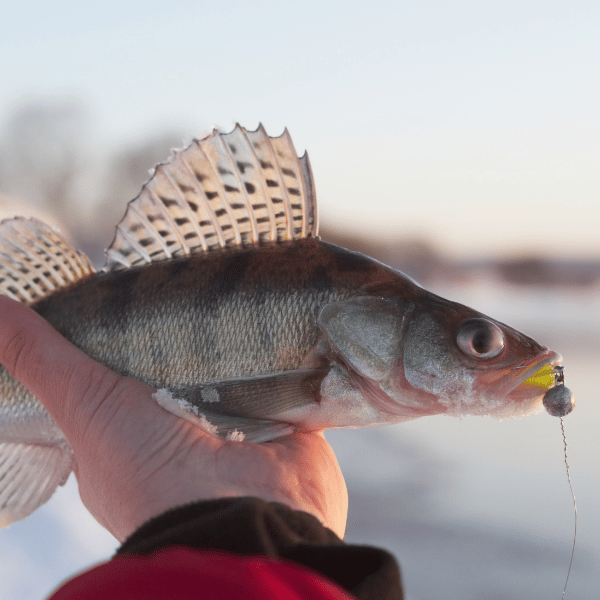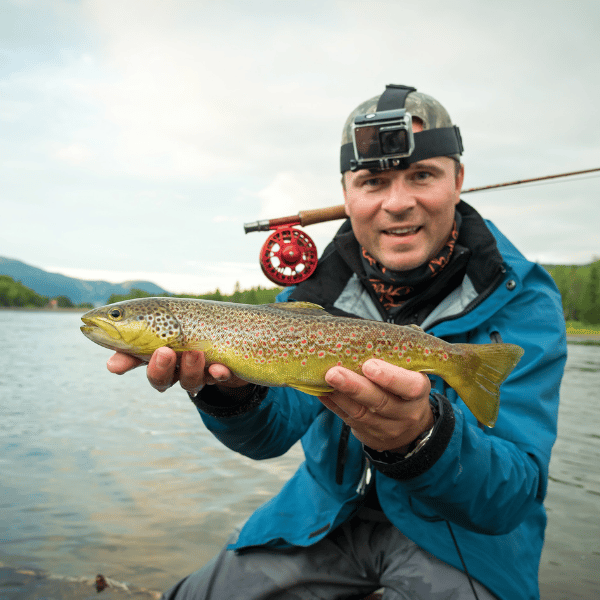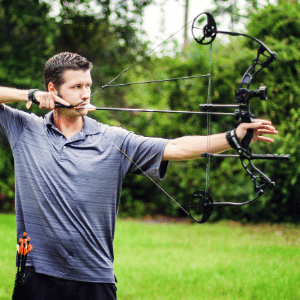
Buying a beginner compound bow can be easy if you know what to look for and what size compound bow to buy.
This beginner compound bow buying guide will walk you through answering all your questions on how to buy a compound bow for the first time.
Contents
Buying a Beginner Compound Bow
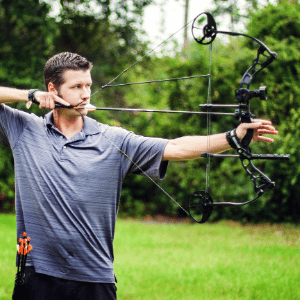
The compound bow was first invented in 1966 by a Missouri man named Holles Wibur Allen. It uses a series of cams and cables to assist with the pulling and holding of the bow.
This does not make a compound bow easier to pull. Instead, the cams are designed to make the bow easier to hold at full draw.
Essentially, a flattish part of the cam partially locks the cable. Instead of holding at 60 or 70 pounds, a bow can be held at 10 or 20 pounds. When the archer releases, the cams quickly rotate out of their locked position, and the full force of the bow propels the arrow forward.
The main advantage of a compound bow is that an archer can hold the bow drawn for longer periods, and with less exertion. You can take your time while lining up a shot, and release when you’re ready, not when your fingers are too tired.
Not only that, but a compound bow increases the effective draw weight that a person can handle. As long as you can draw a given bow all the way, holding it should be a breeze.
The result of all this is that a compound bow provides superior velocity, range, and accuracy when compared to other bows. This makes them the bow of choice for hunters, as well as increasingly for amateur target shooters.
Whether you’re stalking a deer or zeroing in on a stationary target, better control and a softer draw are both major advantages. Compound bows have also created a more friendly shooting environment for women and children, who often can’t rely on brute force to hold a traditional bow drawn.
But how do you choose a compound bow as a beginner? Here’s a quick guide on finding the perfect compound bow for your needs.
Tips for Buying a Beginner Compound Bow
When it comes to buying a first compound bow, there are some initial compound bow buying tips that can help with weeding through the numerous compound bow options out there.
Look Past Marketing
There are numerous compound bow manufacturers with each creating different types of compound bows in every variation they can imagine. Trying to figure out a good compound bow to buy can be difficult with so many options. One of the most important things you can do is look past the marketing and brand names at what really matters – the items we will cover in this guide.
Have a Budget
It is very easy to spend a significant amount of money on compound bows. Fortunately, you can spend a fraction of the amount you could spend on expensive compound bows by working to buy a compound bow on a budget.
Setting a budget and sticking to it will keep you searching for the exact compound bow setup you want without breaking the bank. We will go through the average cost of a compound bow later in this article.
Know the Basics of Compound Bows
The final tip is to take the time to understand the basics of compound bows, including the parts of a compound bow, the different types of compound bows, and what to look for in selecting a compound bow.
You are in the right spot to get this information as the rest of this article will walk you through everything you need to know for the basics of buying a compound bow.
Parts of a Compound Bow
Arrow Rest
The arrow rest is the support that an arrow is rested on the riser. The arrow rest keeps the arrow in place while you draw, aim, and take your shot.
Bowstring
The bowstring weaves through the cams and joins the two ends of the bow to launch the arrow.
Cams
The cams on a compound bow are engineered oblong wheels located at the ends of each limb. Cams transfer the inertia and power built and stored in the limbs on the draw to the bowstring. These are key compound bow components to helping launch the arrow during a shot.
D-Loop
A D-loop attaches to the bowstring right where the arrow is locked onto the bowstring. This is where a release can be attached to apply pressure evenly to make the most accurate shot.
Grip
A compound bow grip is where you hold onto the bow’s riser. Most compound bow grips are removable/replaceable allowing you to adjust and swap them out to make suit your preference.
Limbs
Limbs are planks that are fastened to the bow’s riser and are the flexible composite bridges that support its cam/wheel system. The limbs of a bow are the place of the bow that absorb, store and release energy during a shot.
Limbs are the area of the bow that harness the specific draw weight ranges often seen when looking at bows. Compound bow limbs can be replaced to reach desired draw weight ranges.
Peep Sight
The peep sight is a small circle mounted in the bowstring. It is used to peep through with your aiming eye and line up with the sight on your bow in order to align your arrow with your target.
Sights
Compound bow sights are used for aiming the bow at the target. The sights attach to the riser above the grip and arrow rest.
Sights come in crosshairs, fiber-optic pins, and laser dot options. Different sight options are typically used to ensure an accurate shot in different conditions according to your preferences.
Stabilizer
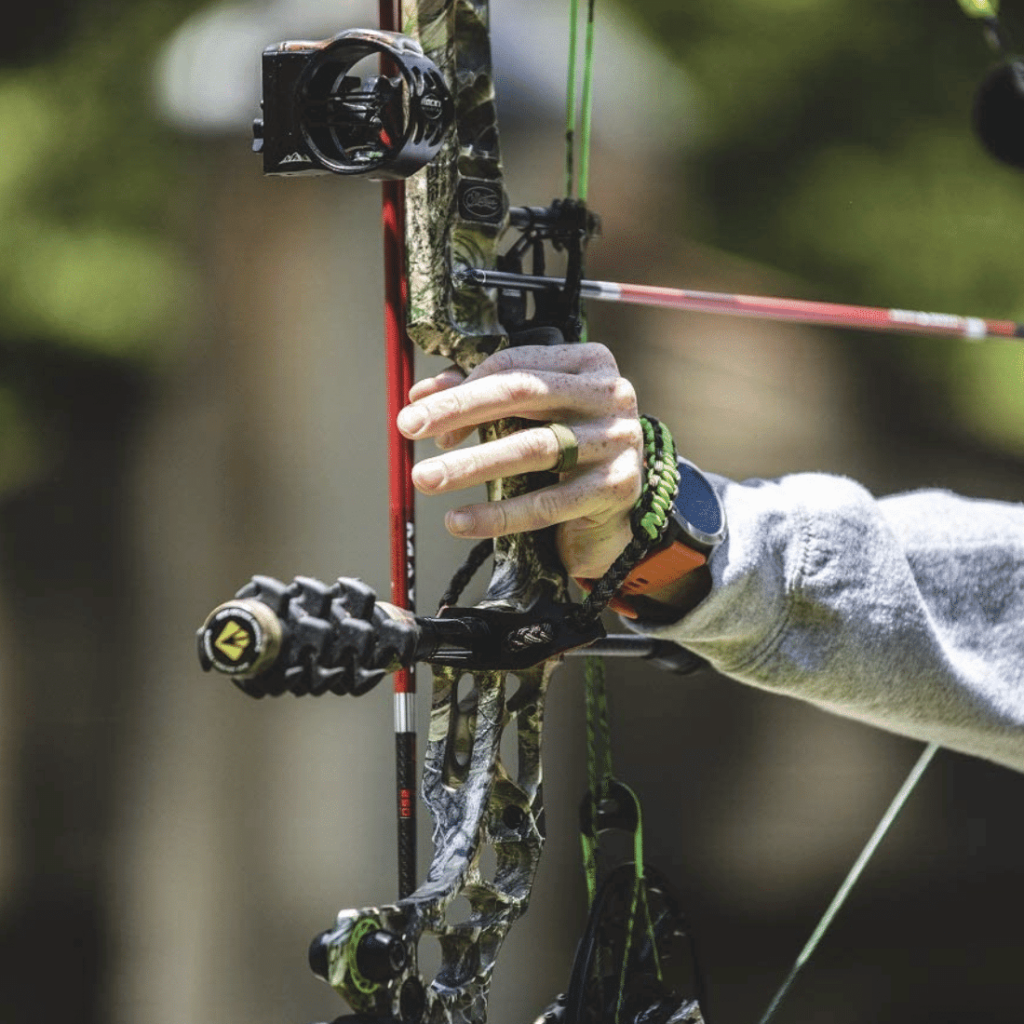
A compound bow stabilizer screws into the riser just below the grip and works to improve the bow’s accuracy. The stabilizer reduces noise and absorbs vibrations.
A compound bow stabilizer can also help steady your aim and balance your shot. They can be removed/replaced with some of the best bow stabilizer options to adjust them with different variations to tune in the length, weight, and materials to improve your shot.
Quiver
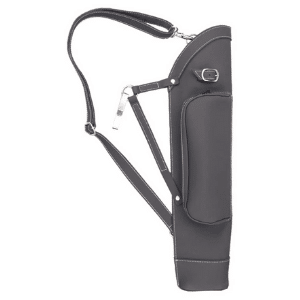
A compound bow quiver holds your arrows. Not every compound bow has a quiver. The bows that do have a quiver lock-in arrows individually with flexible grips and the quiver is removable.
What Makes a Good Compound Bow?
What makes a good compound bow is one that is both reliable and fit for your hunting style. The bow should be made of quality materials, but also within budget.
Since there are different variations and purposes for each variation, you want to make sure it aligns with your hunting style. In the next section, I’ll go through the different types of compound bows so you can get an understanding of the different variations.
Types of Compound Bows
Single Cam Compound Bow
A single cam compound bow has one circular idler wheel at the top of the bow and an elliptical power cam on the bottom doing most of the work. These are also called one cam or solocam compound bows.
The benefits of a single cam are they make the lowest amount of noise and are very user-friendly. The downside is these can have less power than other designs and they are also harder to tune. This makes single cam bows not the best bow type for beginners.
Dual Cam Compound Bow
A dual cam compound bow is a compound bow that has cams at both the top and bottom of the bow. These cams can either be elliptical or they can be completely circular, but they are both symmetrical. These are also called twin-cam compound bows.
Dual cam compound bows have incredible accuracy and velocity capabilities. However, dual cam compound bows can be complex and require consistent tweaking. This makes them not the best beginner compound bow option.
Hybrid Cam Compound Bow
A hybrid cam compound bow is a compound bow that has dual or twin cams that are asymmetrical, or different from each other. The top is the control cam whereas the bottom cam is the power cam.
Hybrid cam compound bows have become very popular, as they are easy to tune and require very low maintenance. These would be one of the best types of beginner compound bows to buy.
Binary Cam Compound Bow
A binary cam compound bow is a compound bow that has a completely unique design compared to the rest. Instead of focusing on using the power within the limbs like the other three designs, binary cam compound bows have a triple groove cam at the top and bottom of the bow with stiffer limbs. This focuses the energy harnessing work on the two cams and the bowstring to create power and velocity.
The binary cam compound bows create the most velocity, but they are also the most complex. These are more advanced bow requiring regular tuning, so they are not the best choice for beginners.
What Size Compound Bow Do I Need?
There are two aspects of a compound bow’s size: draw length and axle-to-axle length.
To find the right bow size, start with the draw length. Draw length is the measurement that needs to be most closely tailored to you as an individual.
Compound Bow Draw Length
The draw length is the distance between the bowstring and the grip when the bow is fully drawn.
Since you’ll be holding the bow in this position a lot, you want it to be as comfortable as possible. This means finding your ideal draw length.
To find your draw length, stand with your back to the wall and spread your arms out wide to the sides. Have a friend measure the distance from one middle finger to the other. If this is too much trouble, you can get a rough estimate of your wingspan by using your height instead. Subtract 15, divide by two, and that’s your draw length.
For example, suppose you’re five feet, nine inches tall. That’s 69 inches. 69 minus 15 is 54. 54 divided by two is 27. So if you’re five feet, nine inches tall, your draw length will be roughly 27 inches. As a side note, your draw length will also be roughly the length of the arrow you need.
Most compound bows have an adjustable draw length, with a range of between 10 and 15 inches. That said, depending on your height, you might have to choose between a bow that’s a little smaller and one that’s a little larger.
In that case, the shorter draw length is better. A draw length that’s too long will not allow you to fully draw your bow, which can severely impact your range and accuracy.
Compound Bow Axle-to-Axle Length
Axle-to-axle length is the distance between the axles on the top and bottom cams. In general, bows with longer draw lengths tend to be longer axle-to-axle, but there are tons of exceptions.
The shape of the bow’s curvature has just as much to do with the draw distance as axle-to-axle length. As a result, it’s possible to find shorter bows with a long draw length, and vice-versa.
The ideal axle-to-axle length will depend on what kind of shooting you’re doing. A longer bow provides better stability. This is useful for target shooting, or for any type of long-distance shooting.
On the other hand, longer bows tend to be heavier and tougher to manage. This makes shorter bows a better choice for most hunters, particularly if you want to stalk your game through any kind of brush.
Am I Left or Right-Eyed?
With many life activities, left and right-handed people will need different equipment. Baseball gloves, golf clubs, guitars, and even firearms come in left and right-handed variants. With archery, though, it doesn’t matter whether you’re right or left-handed. What matters is whether you’re left or right-eyed.
A right-eyed person will shoot right-handed and a left-eyed person will shoot left-handed, regardless of which is the dominant hand.
To be fair, most right-handed people are right-eyed, and vice-versa. But it’s not unusual for people to be “cross-dominant,” either. To be sure, you’ll want to test yourself. Thankfully, this is quick and easy.
Stand somewhere comfortable, with your back straight, and hold your arms fully extended in front of you. Press your thumbs and index fingers together so there’s a triangular opening between them. Now, turn your body, keep both eyes open, and line the opening up with some physical object, like a light switch.
With that object-centered, close one eye. Open both eyes again, then close your other eye. One of those times, the object will stay in view; the other time, it will jump out of view. The eye that keeps the object centered between your hands is your dominant eye.
Compound Bow Draw Weight
Draw weight should be the third thing you take into consideration, but this doesn’t mean it’s not important. It’s because most bow models are available in multiple draw weights.
The easiest way to find the ideal bow is to find one you like in the right size, then look for the best draw weight.
Regardless, you’ll want to choose the highest draw weight that you can manage. There are a few reasons for this.
First, more draw weight gives you better range and accuracy. The range also equates to velocity, which means the arrow delivers more force. These factors are important for target shooters and 3D archers because you want the best range performance.
However, accuracy and velocity are also major ethical considerations for hunting. When you shoot at an animal, it’s a moral imperative to deliver a quick, clean kill for your prey.
Most states have a minimum legal draw weight for hunting, typically between 40 and 50 pounds, to make sure you have enough power to ensure a quick, clean kill. If you’re hunting, your bow will need to meet this minimum threshold in order to be legal.
For that reason, youth and female hunters tend to use compound bows in the 45 to 50-pound range. They’re powerful enough to be legal and ethical, but still light enough to draw and hold. Male hunters tend to use bows in the 50 to 70-pound range, depending on the size and strength of the man.
These numbers are only rough guidelines. If you’re not sure what works for you, you will want to take a trip to your local archery store. There you can draw bows of various weights, and get an idea of what they feel like.
If you can handle a more powerful, by all means, use one! Just remember that if you’re hunting, you’ll need to draw, hold, and fire accurately, even after a morning tromping through the woods.
Also, remember that you also may be drawing your bow repeatedly. If you can draw it easily with a fresh arm, you might not be able to do it after drawing your bow over and over again.
Also, keep in mind that these numbers are for composite bows. Recurve bows require you not just to pull through the highest possible weight, but also to hold at that level of tension. An average man can pull a 60-pound bow, but can’t hold a 60-pound recurve in place.
Average Cost of a Compound Bow
The average cost of a compound bow is around $500. It’s not unusual to see compound bows that cost well over $1,000. However, for a beginner compound bow, it is best to at least have a budget of $300.
Spending $300 on a compound bow will put you at a sweet spot of getting a quality, feature-packed compound bow without feeling like you spent too much on something that has the potential of not working out for you.
Bows in the $300 price range are workhorses. The bows in this price range do not have all the bells and whistles as the $400-600+ bows, but they are perfect to use for your first few years and eventually hand down in the family.
Price isn’t always an indication of quality. For instance, most fast bows are more expensive. This is great if you’re an experienced archer who wants to be able to make quick follow-up shots. But faster bows are less forgiving, and speed magnifies any mistakes with aiming or technique.
Another important thing to think about is any accessories you might need. Most bows will require a stabilizer, an arrow rest, sights, and a wrist strap.
There are plenty of kits available, or you can buy individual parts to get the best mix of accessories for your needs. This can be more expensive, but it might be worth spending an extra $50 on the perfect arrow rest and sight, even if that means you can only afford a bow that costs $50 less.
